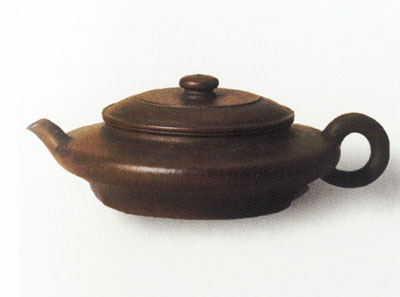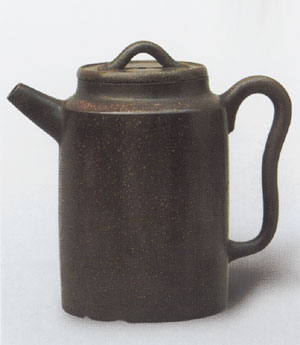
Qing Dynasty, Big picking up pot
Lying in the east Jiangsu Province, Yixing is well known for Zisha (purple clay) Teapot. Zisha Teapot is made from the unique clay in the region of Yixing, which is fine and contains much iron content. Made of this kind of clay, the porcelain is mostly red brown, light yellow and blackish purple. Zisha porcelain was popularized in the period from the Song Dynasty (960-1279) to the mid Ming Dynasty (1368-1644), due to the change of the ways of brewing tea.

Qing Dynasty, Flat pot
Focusing on practical use, the Zisha teapots in the Ming Dynasty mainly took geometric designs, simple but harmonious. The rough grains of the clay highlight the plainness as well as the elegance of the vessels. Blemishes can always be found on the surface of the vessels because of the underdeveloped techniques at that time. The colors of the vessels are always reddish brown and purple gray because of the material and the firing time. From the Zhengde reign to the Wanli reign (1505-1620) in the Ming Dynasty, the masters of the Zisha Teapot making, Gong Chun, Li Zhongfen, Shi Dabin, and Xu Youquan, etc made great contribution to the improvement and development of the Zisha Teapot techniques.

Qing Dynasty, High barrel pot
The popularization of the Zisha teapot was much resulted from the change of the ways of brewing tea. People at that time brewed tea instead of boil it, thus raised the requirement for teapot. In practice, people found that the Zisha teapot was not only well designed but also a good choice for tea brewing. The body of the teapot can absorb some fragrance of the tea and keep it for a long time. The longer the teapot is used, the better the flavor is. The Zisha teapot has no glaze or bright color; the plainness fits the aesthetic views and taste of literators, so it was prevalent all around the country. In addition, the Zisha crafts absorbed the characteristics of the bronze craft of that time and were also of the same style with the furniture.










